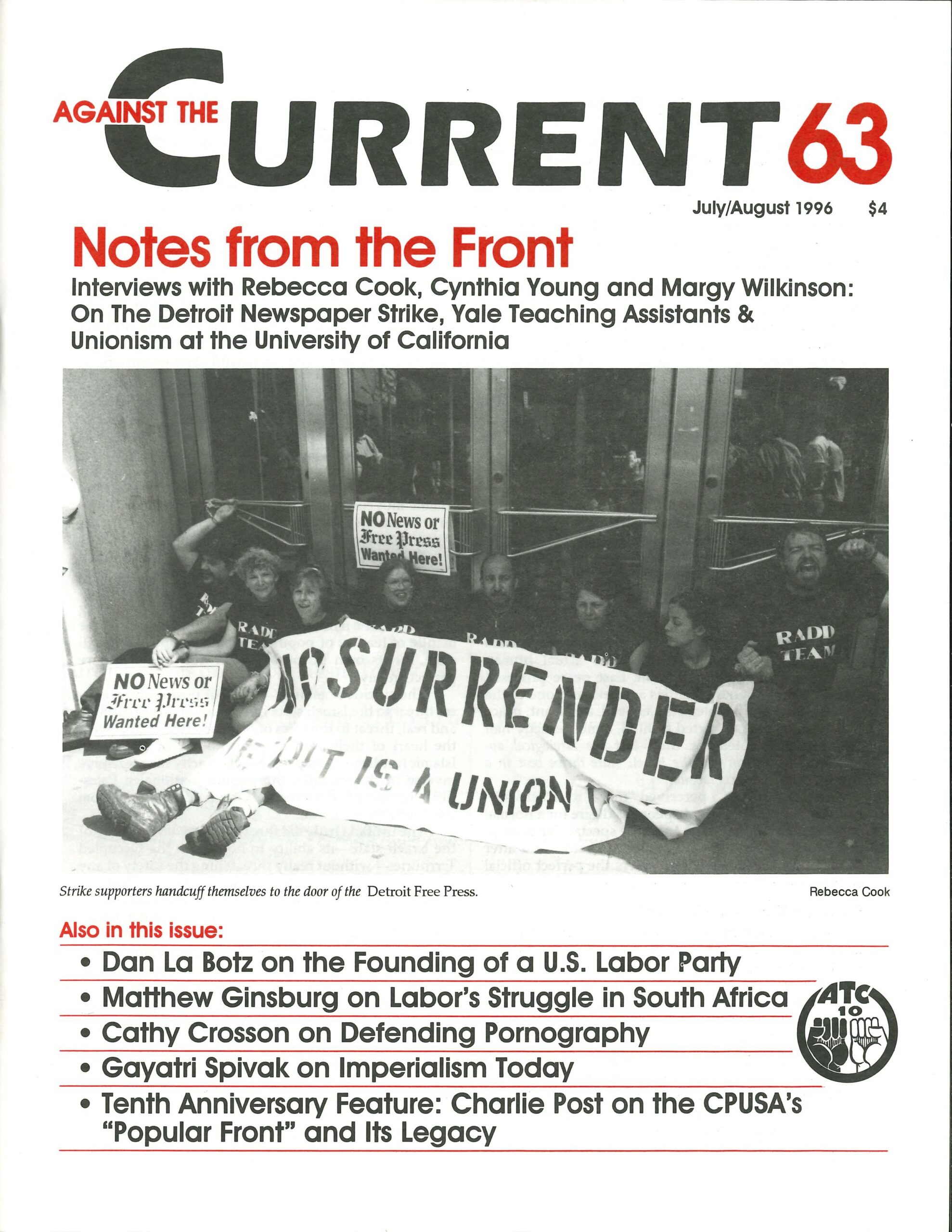Against the Current, No. 63, July/August 1996
-
Israel's Poisoned Fruits of Oslo
— The Editors -
Founding the Labor Party
— Dan La Botz -
Detroit Newspaper Unions' Year of War
— interview with Rebecca Cook -
The Yale Grad Student Strike
— an interview with Cynthia Young -
A New Campus Union at University of California
— Claudia Horning interviews Margy Wilkinson -
The "Team Bill," A Poison Bill
— Ellis Boal -
Class and the African-American Leadership Crisis
— Malik Miah -
South African Labor Marching Again
— Mathew Ginsburg -
More on "Imperialism Today"
— Gayatri Chakravorty Spivak -
The Comintern, CPUSA & Activities of Rank-and-File CPers
— Charlie Post -
The Popular Front: Rethinking CPUSA History
— Charlie Post -
Queer Vows, Pros and Cons
— Catherine Sameh -
Radical Rhythms: "Global Divas"
— Kim Hunter -
Letter to the Editors
— Paul LeBlanc -
Random Shots: Wages and Other Minima
— R.F. Kampfer - Reviews
-
Pornography and the Sex Censor
— Cathy Crosson -
Reading Red Women Writers
— Renny Christopher -
The Uses of Dmitri Volkogonov
— Samuel Farber -
Trotsky Assassinated Again
— Susan Weissman
Paul LeBlanc
PETER DRUCKER’S LETTER (ATC 61), in defending the revolutionary honor of Max Shachtman, takes issue with my article “Challenges of a Black Revolutionary: The Marxism of CLR James” (ATC 60). But what I wrote was not meant to cast aspersions on Shachtman.
I noted sharp differences that led to the 1947 split of James and his co-thinkers from the Workers Party led by Shachtman: 1) on the nature of the Black liberation struggle, 2) on evaluating the U.S. working class, and 3) on the question of unity with the Socialist Workers Party led by James P. Cannon (dramatically resolved when Shachtman drew back and James moved ahead to unify).
These were not polemical points, simply factual statements.
I reported James had “the position that the American working class was far more radical, having a greater revolutionary character, than many of the Shachtmanites imagined.” (ATC 60: 26) Peter says this was linked to the question of whether or not U.S. capitalism would experience a post-war depression or prosperity — with Shachtman demonstrating “greater realism” in economic predictions. This, however, distorts what the difference was about.
James and the tendency he led were famous for their belief — as they put it when they broke with Shachtman’s organization — that “the proletariat today is not in any sense of the word ‘backwards’ and is devoid of democratic or pacifist illusions…The proletariat has illusions but they are revolutionary illusions. It is ready for revolution today as never before.” (Trotskyism in the United States, 1940-47: Balance Sheet, the Workers Party and the Johnson-Forest Tendency,” Detroit: Johnson-Forest Tendency, August 1947: 27)
They gave special stress in this assessment to African Americans, women and youth. Against this perspective leading Shachtmanite spokesperson Irving Howe insisted that “the real situation today with regard to American workers” centered on “the contradiction between their fresh and increasingly bold economic struggle and their comparative political backwardness.” (“On Comrade Johnson’s American Resolution — Or Soviets in the Sky,” Bulletin of the Workers Party, March 28, 1946: 28)
It can be argued that one side or the other was more insightful or revolutionary. I discuss this and related issues in the extensive introductory essay in the 1994 volume I edited with Scott McLemee,CLR James and Revolutionary Marxism, as well as in my contributions to the new book co-authored with George Breitman and Alan Wald, Trotskyism in the United States. (Both of these, as well as Peter’s biography Max Shachtman and His Left, are published in the Revolutionary Studies series of Humanities Press.)
Still, a reason for the split was the difference noted in my ATC article — whether the U.S. working class was revolutionary or backward — not whether an economic depression was around the corner.
ATC 63, July-August 1996

